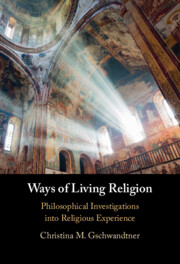Book contents
- Ways of Living Religion
- Ways of Living Religion
- Copyright page
- Dedication
- Contents
- Preface
- Acknowledgments
- Introduction
- 1 Ascetic Experience
- 2 Liturgical Experience
- 3 Monastic Experience
- 4 Mystical Experience
- 5 Devotional Experience
- 6 Compassionate Experience
- 7 Fundamentalist Experience
- Conclusion
- Bibliography
- Index
6 - Compassionate Experience
Published online by Cambridge University Press: 07 March 2024
- Ways of Living Religion
- Ways of Living Religion
- Copyright page
- Dedication
- Contents
- Preface
- Acknowledgments
- Introduction
- 1 Ascetic Experience
- 2 Liturgical Experience
- 3 Monastic Experience
- 4 Mystical Experience
- 5 Devotional Experience
- 6 Compassionate Experience
- 7 Fundamentalist Experience
- Conclusion
- Bibliography
- Index
Summary
This chapter considers compassionate experience, using as examples the Pietist diaconate movement in Germany in the nineteenth century, the Catholic Worker, and the L’Arche movement. The chapter shows that such compassionate practice is usually motivated by a recognition of precarity and need, a “seeing” of suffering or “hearing” of the cry of the other. Those who engage in compassionate experiences identify with the poor and suffering, often to the point of joining them or sharing in their plight. Their actions are marked by compassion, which is more than a feeling of pity, but involves deep commitment to understanding and ameliorating the plight of others or enabling them to improve it themselves. Such generous acts of hospitality often go far beyond the bounds of what seems reasonable or even humanly possible. Compassionate experience is focused less on the religious self but instead is devoted to the other, whether religious or not.
- Type
- Chapter
- Information
- Ways of Living ReligionPhilosophical Investigations into Religious Experience, pp. 225 - 268Publisher: Cambridge University PressPrint publication year: 2024

